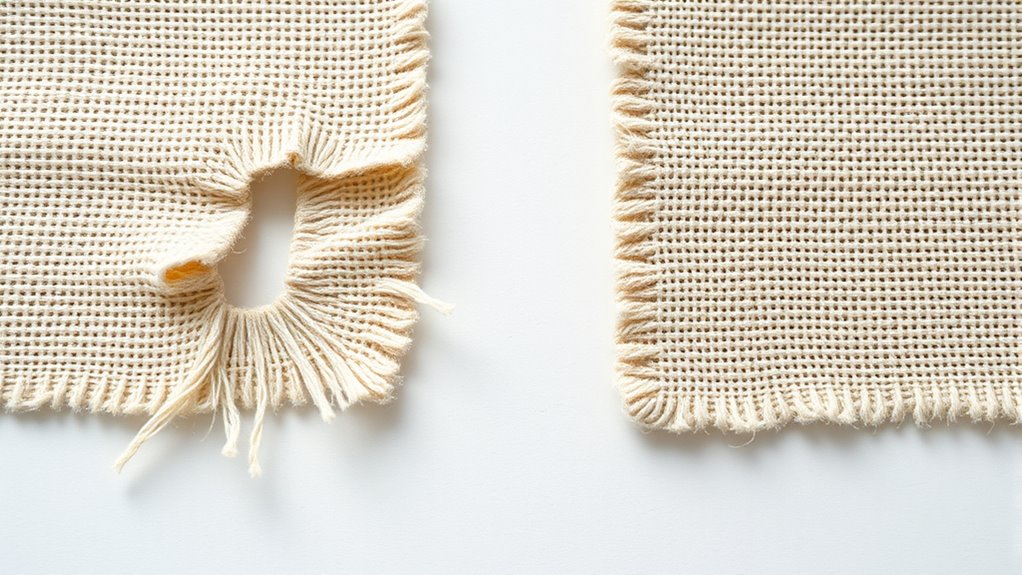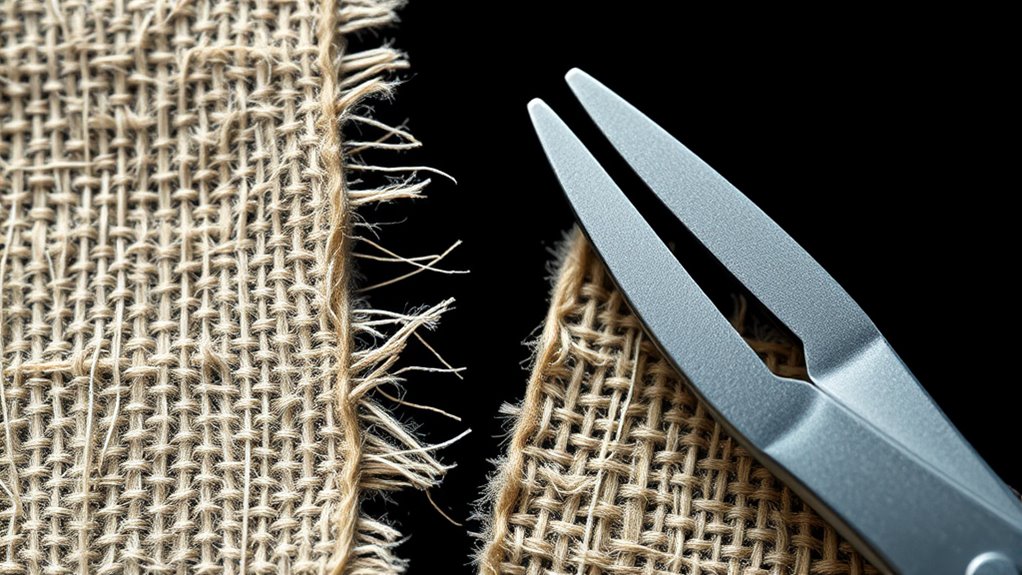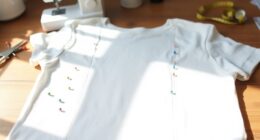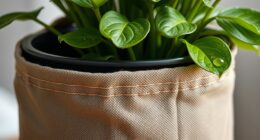Choosing between tear and snip tests depends on your fabric and project. The tear test is quicker and less invasive, giving you a good initial idea of the grain, but it may be less precise on delicate or complex fabrics. Snipping allows for more control and confirms thread lines, which is helpful for tricky fabrics. Often, combining both methods gives the most reliable results—keep exploring to learn how these techniques can improve your sewing accuracy.
Key Takeaways
- Tear tests are quick and non-invasive, ideal for initial fabric assessment.
- Snipping provides precise confirmation of warp and weft alignment, especially for delicate fabrics.
- Combining both methods enhances accuracy in identifying fabric grain.
- Tear tests may produce uneven results on fraying or stretchy fabrics, where snipping is more reliable.
- The best approach depends on fabric type; using both methods ensures more confident identification.

Understanding the fabric grain is essential when working with textiles, as it affects how the fabric behaves and drapes. When you’re sewing or designing, knowing the grain direction helps ensure your project turns out neat and professional. To determine the fabric grain, you need reliable fabric grain test techniques. These methods help you identify the lengthwise and crosswise threads, ensuring you cut and sew along the correct grain lines. Accurate testing is crucial because it directly influences how your fabric will behave — whether it will hang smoothly or warp over time.
Knowing the fabric grain ensures proper drape and professional sewing results.
One common approach is the tear test, where you gently tear the fabric along its length or width to see how it naturally splits. This method is straightforward and gives you immediate insight into the fabric’s grain direction. If the fabric tears straight and clean, it indicates a strong grain line, which you can follow confidently. However, tear tests aren’t foolproof; some fabrics tear unevenly or fray, which can make it challenging to determine the precise grain line. That’s why understanding the limitations of tear-based fabric grain test accuracy is vital. It helps you interpret results more accurately and decide whether to rely solely on tearing or supplement your test with other techniques.
On the other hand, snipping involves making small, controlled cuts along the fabric’s edges or across specific points. This method allows you to observe how the fabric responds to cutting and how the threads run. When you snip, you’re able to see if the cut aligns with the warp or weft threads, confirming the grain direction more precisely. Snipping can be especially helpful with fabrics that don’t tear cleanly, such as those with a lot of stretch or delicate weaves. Plus, it allows you to test specific areas without risking damage to the entire fabric piece. Still, the effectiveness of snipping depends on how carefully you execute the cuts and interpret the results.
Choosing between tear and snip techniques depends on the fabric type and your project needs. Tear tests are quicker and less invasive but may lack precision for certain fabrics. Snipping offers better control and accuracy, especially with complex or delicate textiles. To maximize fabric grain test accuracy, you might combine both methods. Start with a tear test to gauge the fabric’s natural tendency, then confirm your findings with snips. This dual approach helps you confidently identify the grain, reducing errors during cutting and sewing. Ultimately, understanding which technique works best for each fabric ensures your projects look polished and fit perfectly, making your sewing experience smoother and more successful. Additionally, being familiar with fabric characteristics from the history of pinball machines can provide insights into material durability and handling, which indirectly benefits fabric selection and testing.
Frequently Asked Questions
Can Fabric Grain Tests Predict Fabric Durability?
You might wonder if fabric grain tests can predict fabric durability. While these tests assess fabric strength and help identify grain alignment, they don’t directly measure durability. The test accuracy varies depending on the method used, but it mainly indicates how well the fabric will hold up under stress. So, while useful, fabric grain tests are just one piece of the puzzle in predicting overall fabric longevity.
Are Some Fabrics Unsuitable for Tear or Snip Tests?
Some fabrics may be unsuitable for tear or snip tests due to their fabric composition. Delicate materials like silk or lace can tear easily or get damaged during testing, making accurate results difficult. Also, certain fabrics require specialized testing equipment to evaluate their durability properly. You should choose the appropriate test based on the fabric’s properties to avoid damaging valuable or sensitive textiles and guarantee reliable assessments.
How Does Fabric Weight Affect the Test Results?
You might notice that fabric weight influences test accuracy, as lighter fabrics tend to tear more easily, making the test less reliable. Heavier fabrics are sturdier, giving more consistent results whether you tear or snip. By considering fabric weight, you can choose the appropriate test method, ensuring more accurate assessments of the fabric’s grain. Adjusting your approach based on weight helps you get clearer, more dependable test outcomes.
Can Improper Testing Damage Delicate Fabrics?
Many believe improper testing can damage delicate fabrics, but is that true? If you handle fabrics with poor technique or excessive force, you risk compromising fabric quality and skewing testing accuracy. Gentle methods ensure you maintain the fabric’s integrity, especially for delicate textiles. Properly conducted tests protect fabric quality and give reliable results, so always follow correct procedures to avoid unnecessary damage and ensure accurate assessments.
Which Test Is Better for Stretchy or Elastic Fabrics?
When testing stretchy fabrics with elastic fibers, tearing isn’t ideal because it can damage the delicate material and alter its stretchability. Instead, snipping is a better choice because it’s less invasive and preserves the fabric’s integrity. You can gently cut a small section to check the grain without risking damage, ensuring the fabric remains functional and durable for your project.
Conclusion
So, whether you choose to tear or snip, think of it like a dance with your fabric—tearing is a bold leap, revealing the true grain like a daring plunge into the unknown, while snipping is a gentle step, offering control and precision. Both methods have their rhythm, but trust your instincts and the feel of your material. After all, mastering your fabric’s grain is the secret to sewing success, turning raw textiles into a beautifully woven story.








